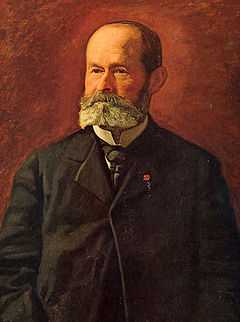Taensa language
| Taensa | |
|---|---|
| Created by | Jean Parisot |
| Date | 1882 |
| Purpose |
fraud |
| Language codes | |
| ISO 639-3 |
None (mis) |
| Glottolog |
(insufficiently attested or not a distinct language)taen1234[1] |
The Taensa language was purportedly the language spoken by the Taensa people of northeastern Louisiana, according to a grammar published in the early 1880s by two French students. The language was unique, and the grammar aroused great interest among linguists. Later it was determined that the grammar was a hoax and the language did not exist.
Background
The Taensa Indians belonged to the Natchez nation, but had moved away before the Natchez Massacre initiated by Governor Bienville. The Natchez, and thus the Taensa, spoke a Muskogean language. Over time some small differences in pronunciation may have emerged, but the languages were essentially the same.[2] From the early nineteenth century the Taensa became intermixed with other groups, particularly the Chitimacha. Their language survived into the second half of the nineteenth century, and there were still people who identified themselves as Taensa in the 1930s.[3]
Document

In the 1880s two French students published a grammar and other material of what they claimed to be the hitherto undocumented language of the Taensa people of Louisiana.[4] Jean Parisot, who submitted the documents for publication in Paris, was a nineteen-year-old student at a seminary in Plombières, France.[5] The Grammaire et vocabulaire de la langue Taensa, avec textes traduits et commentés par J.-D. Haumonté, Parisot, L. Adam was published in 1882 in Paris and caused a stir among linguists.[6]
The material included an outline of the grammar, vocabulary and fragments of text in the Taensa language.[7] Parisot claimed that it was from Spanish sources written in Louisiana. When the material was published, two eminent French Americanists, Lucien Adam and Julien Vinson, supported the work.[8]
Controversy
Albert Samuel Gatschet defended the work at first.[8] Gatschet stated that the language was unrelated to any other.[6] In 1885 he started studies in Indiana, and thereafter became silent on the subject. The eminent ethnologist Daniel Garrison Brinton was also taken in at first. Writing of native American literature in 1883, Brinton quoted a complete song from the grammar, praising the songs as "Ossianic in style."[9] Later Brinton reversed his position and declared that the material was fake, publishing his reasons in 1885.[8] Vinson also came to believe it was a hoax.[6] Adam continued to defend the work for a while, but in 1885 he and Brinton co-authored Le Taensa a-t-il été forgé de toutes pièces, which discussed whether the entire work was a forgery.[10]
The fraud may have been the work of Parisot, or may have been the work of an unknown person who created the manuscripts and gave them to Parisot.[11] When the scandal broke in 1885, Adam and Parisot jointly stated that the documents had not been Parisot's work.[12] Parisot later spent time in Turkey and in 1898 and 1902 published further works on linguistics based on his experience there.[8]
John R. Swanton published definitive works in 1908 and 1910 that removed all doubt based on primarily historical rather than linguistic grounds.[8] The text showed "palpable and gross" evidences of fraud.[6] Swanton showed that the Taensa people spoke the Natchez language.[4]
References
Citations
- ↑ Nordhoff, Sebastian; Hammarström, Harald; Forkel, Robert; Haspelmath, Martin, eds. (2013). "Taensa". Glottolog. Leipzig: Max Planck Institute for Evolutionary Anthropology.
- ↑ Abney 2011, p. 7.
- ↑ Kniffen & Gregory 1994, p. 77.
- ↑ 4.0 4.1 Campbell 1997, p. 13.
- ↑ Sturtevant 2005, p. 42.
- ↑ 6.0 6.1 6.2 6.3 Boas 1911, p. 172.
- ↑ Sturtevant 2005, p. 42-43.
- ↑ 8.0 8.1 8.2 8.3 8.4 Sturtevant 2005, p. 43.
- ↑ Bendix 2009, p. 132.
- ↑ Adam & Brinton 1885.
- ↑ Mooney 1912.
- ↑ Adam & Parisot 1885.
Sources
- Abney, Don (2011-03-29). The Complete Louisiana Catahoula Leopard Dog. AuthorHouse. ISBN 978-1-4567-5523-2. Retrieved 2013-04-24.
- Adam, Lucien; Brinton, Daniel Garrison (1885). Le Taensa a-t-il été forgé de toutes pièces. Maisonneuve. Retrieved 2013-04-24.
- Adam, Lucien; Parisot, Jean (1885). Dom Parisot ne produira pas le manuscrit Taensa. Lettre, etc. Retrieved 2013-04-24.
- Brinton, Daniel Garrison (1885). The Taensa Grammar and Dictionary: A Deception Exposed. F. H. Revell. Retrieved 2013-04-24.
- Bendix, Regina (2009-07-30). In Search of Authenticity: The Formation of Folklore Studies. Univ of Wisconsin Press. ISBN 978-0-299-15543-8. Retrieved 2013-04-24.
- Boas, Franz (1911). Introduction to Handbook of American Indian languages. U of Nebraska Press. ISBN 978-0-8032-5017-8. Retrieved 2013-04-24.
- Campbell, Lyle (1997). American Indian Languages. Oxford University Press. ISBN 978-0-19-534983-2. Retrieved 2013-04-24.
- Kniffen, Fred Bowerman; Gregory, Hiram F. (1994-09-01). The Historic Indian Tribes of Louisiana: From 1542 to the Present. LSU Press. ISBN 978-0-8071-1963-1. Retrieved 2013-04-24.
- Mooney, James (1912). "Taensa Indians". The Catholic Encyclopedia 14 (New York: Robert Appleton Company) http://www.newadvent.org/cathen/14429c.htm. Retrieved 2013-04-24. Missing or empty
|title=(help) - Sturtevant, William C. (2005). "History of Research on the Native Languages of the Southeast". Native Languages Of The Southeastern United States. U of Nebraska Press. ISBN 978-0-8032-4235-7. Retrieved 2013-04-24.
Bibliography
- Parisot, Jean; Adam, Lucien (1882). Grammaire et vocabulaire de la lange taensa. Kraus Reprint. Retrieved 2013-04-24.
- Swanton, John Reed (1908). "The Language of the Taensa". American Anthropologist 10: 24–32. doi:10.1525/aa.1908.10.1.02a00040.